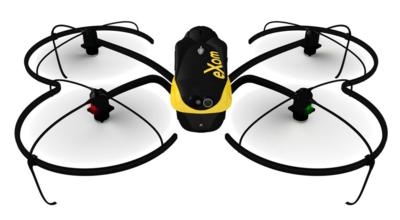Wed, May 06, 2015
eXom Says senseFly’s New Aircraft 'Ready For Take-Off'
Swiss professional UAV maker senseFly has launched the eXom, its highly-anticipated quadcopter UAS for mapping and inspection. The eXom is available to pre-order immediately and ships this summer.

The eXom is a uniquely sensor-rich system. Developed by experts working across numerous fields of robotics, this lightweight quadcopter offers professionals such as civil engineers and land surveyors the situational awareness, imaging flexibility and durability they need to complete challenging tasks safely, accurately and efficiently.
“We believe the eXom’s level of application-focused technology is unique in the civilian drone market,” said Antoine Beyeler, CTO and co-founder of senseFly. “This platform tightly integrates several one-of-a-kind features, such as TripleView imaging, advanced situational awareness and full flight mode flexibility—to provide inspection and mapping professionals with the functionality they desire from a rotary system.”
eXom is a future-ready platform with a quad-core computer onboard. Like senseFly’s fixed-wing drones, it offers users ever-evolving performance through regular software updates, adding the latest drone tech innovations to keep the eXom at the cutting edge for years to come.
The company says eXom’s low take-off weight of 3.7 pounds ensures its users will, in many countries, have less flight authorization paperwork to deal with than those who use heavier systems.
The eXom contains a rich array of advanced integrated sensors. These work together to provide the user with full situational awareness and support obstacle avoidance:
- Five ‘navcam’ vision sensors allow the operator to see in the direction the drone is moving, automatically via its flight control software, without needing to turn the system’s TripleView camera head. This technology is unique in such a lightweight UAS, similar to the visual parking sensors in modern cars, but brought into a 3D flight environment.
- Five ultrasonic proximity sensors work in harmony with eXom’s navcams to ensure the operator always knows the drone’s distance from nearby objects. (The drone’s shock-absorbent carbon fibre shrouding is also always on hand to protect its rotors in case of surface contact.)
- Numerous other sensors, including inertial measurement units, barometers, magnetometers, GPS and magnetic encoders, maximise the drone’s stability and safety.

Additionally, the company says eXom’s autopilot-controlled TripleView camera head enables the user to view and record three different types of imagery during a single flight without needing to land to change cameras.
Since the TripleView head faces forwards, eXom can fly up close to target structures such as building walls and dams to achieve sub-millimetre data resolutions. Plus, because of the head’s 270° vertical field of view, users can document objects positioned directly above and below the drone; crucial for tasks such as bridge and roof inspections.
eXom offers several flight plan modes, including:
- Autonomous mode, which allows operators to create a flight plan using eMotion X’s mission blocks. The aircraft then launches, flies, acquires geo-referenced imagery and lands itself.
- Interactive ScreenFly mode, a streaming video mode for live inspection tasks. The supplied joypad allows the operator to navigate and orientate the drone via computer screen. This mode includes flight assistance features such as cruise control and distance lock. Operators can switch back and forth between the two modes during flight.
- RC-based manual control always remains available as a backup function and for experienced pilots.
(Images provided by senseFly)

More News
Aero Linx: JAARS Nearly 1.5 billion people, using more than 5,500 languages, do not have a full Bible in their first language. Many of these people live in the most remote parts of>[...]
'Airplane Bounced Twice On The Grass Runway, Resulting In The Nose Wheel Separating From The Airplane...' Analysis: The pilot reported, “upon touchdown, the plane jumped back>[...]
"Burt is best known to the public for his historic designs of SpaceShipOne, Voyager, and GlobalFlyer, but for EAA members and aviation aficionados, his unique concepts began more t>[...]
"Polaris Dawn, the first of the program’s three human spaceflight missions, is targeted to launch to orbit no earlier than summer 2024. During the five-day mission, the crew >[...]
There Are SO Many Ways To Get YOUR Aero-News! It’s been a while since we have reminded everyone about all the ways we offer your daily dose of aviation news on-the-go...so he>[...]
 ANN's Daily Aero-Linx (05.04.24)
ANN's Daily Aero-Linx (05.04.24) NTSB Final Report: Quest Aircraft Co Inc Kodiak 100
NTSB Final Report: Quest Aircraft Co Inc Kodiak 100 Aero-News: Quote of the Day (05.04.24)
Aero-News: Quote of the Day (05.04.24) Aero-News: Quote of the Day (05.05.24)
Aero-News: Quote of the Day (05.05.24) Read/Watch/Listen... ANN Does It All
Read/Watch/Listen... ANN Does It All





